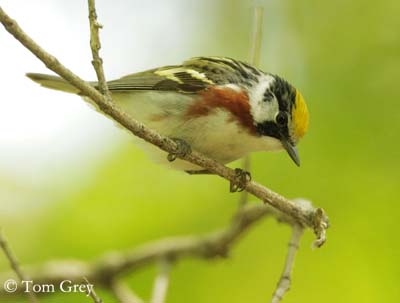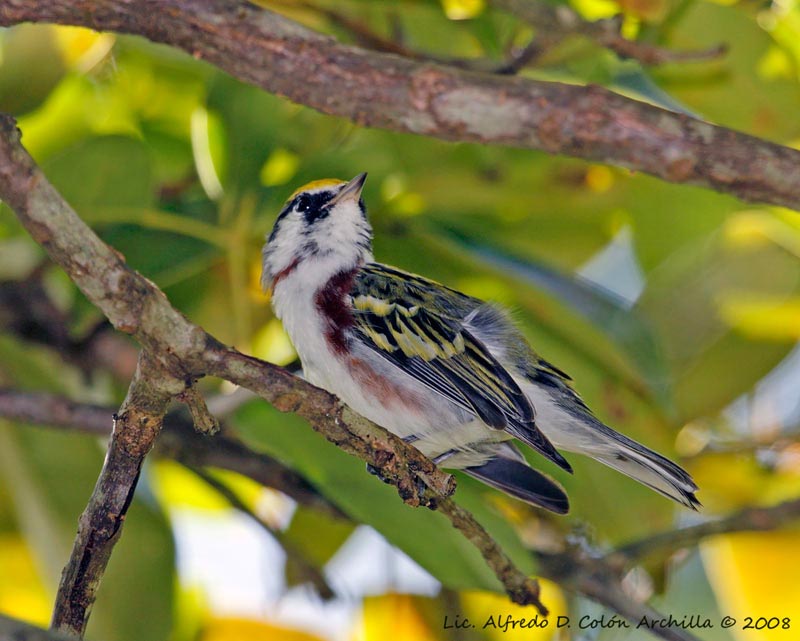
Chestnut-sided Warbler
Setophaga pensylvanica
Passeriforme Order - Parulidae Family
BIOMETRICS:
Length: 11cm; Wingspan: 18-21cm; Weight: 8 to 13 g
LONGEVITY: 7 years
DESCRIPTION:
Chestnut-sided warbler in winter plumage is unstreaked lime green on crown and upperparts (adult male may show weak dark streaks on crown and mantle), contrasting with greyish-white ear-coverts and entire underparts, and with blackish wings, the latter with two bold yellowish-white bars. A white eye ring may be noticeable. Dark tail shows whitish patches, and bill and legs are blackish.

BEHAVIOUR:
Chestnut-sided warbler feeds in low shrubbery and small trees, hopping through foliage and chasing insects in short flights. It often cocks the tail. It also gleans insects from the underside of leaves. Occasionally, it forages with other species, but generally, it forages alone.
Chestnut-sided warbler is highly territorial during the breeding season. Before females arrive, male establishes territory by continuous singing and aggression. First, when females arrive, it acts very aggressively. After copulation, it follows and guards the female.
It migrates with other flocks at night.
DIET:
Chestnut-sided warbler feeds primarily on insects, a lot of small flies and larvae of butterflies and moths. It may also eat other small invertebrates like spiders. In winter, they eat some fruit and seeds.
PROTECTION / THREATS / STATUS:
Chestnut-sided warbler declines with increased expansion of agriculture, urbanization and loss of suitable habitat as forest. Pesticides, cowbird parasitism, frequent collisions with TV towers and buildings, are the other threats known.
Fr: Paruline à flancs marron
All: Gelbscheitel-Waldsänger
Esp: Chipe Pardo-blanco
Ital: Dendroica fianchicastani
Nd: Roestflankzanger
Russe: Желтошапочный лесной певун
Sd: Brunsidig skogssångare
Photograph by Alfredo Colón
Puerto Rico Wildlife
Tom Grey
Tom Grey's Bird Pictures
Photos de Bob Moul
Son site:
Nature Photography
Text by Nicole Bouglouan
Sources:
THE HANDBOOK OF BIRD IDENTIFICATION FOR EUROPE AND THE WESTERN PALEARCTIC by Mark Beaman, Steve Madge - C.Helm - ISBN: 0713639601
FIELD GUIDE TO THE BIRDS OF NORTH AMERICA –National Geographic Society - ISBN: 0792274512
All About Birds (Cornell Lab of Ornithology)
Wikipedia (Wikipedia, The Free Encyclopedia)
Animal Diversity Web (University of Michigan Museum of Zoology)
What Bird-The ultimate Bird Guide (Mitchell Waite)
Birds of Nova Scotia (Robie Tufts)
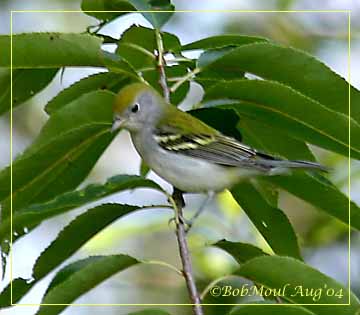
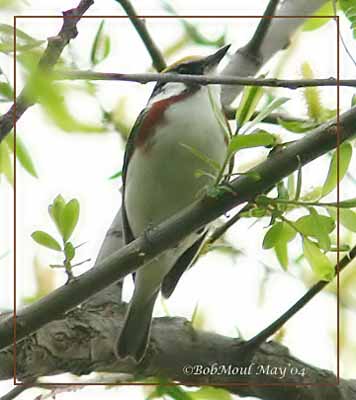
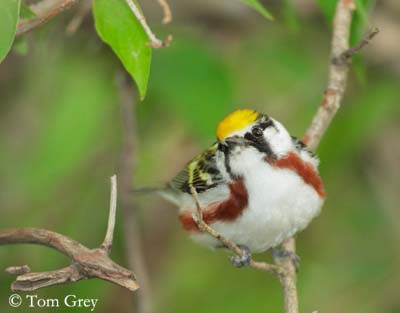
VOICE: SOUNDS BY XENO-CANTO
Chestnut-sided warbler’s usual call is a sharp “chip”, slightly softer than the call of Yellow warbler. The song is loud, clear, somewhat variable whistling, sometimes rendered “pleased-pleased-pleased-to-meetcha”, usually accented at the end. Young birds learn song from adults.
HABITAT:
Chestnut-sided warbler breeds in bushy undergrowth, thickets and areas of small trees, especially favouring woodland edges, second grows, cleared deciduous woodland and abandoned fields or pastures.
It winters in moist tropical forest.
RANGE:
Chestnut-sided warbler breeds from Central Saskatchewan, eastward to Nova Scotia, southward to N Minnesota, S Pennsylvania, and S in Appalachians to N Georgia.
It winters in Central America, from S Mexico to Panama.
FLIGHT:
Chestnut-sided warbler has rapid and agile flight, for chasing insects in short flights.
REPRODUCTION:
Chestnut-sided warbler’s nest is built by the female alone, in deciduous tree or shrub. It is a loosely woven cup made with a variety of plant parts, like bark stripes, weed stems, grasses, plant down, sedges and rootlets.
Female lays 4 white eggs, spotted with brown. Incubation lasts about 11 to 12 days, by female too. Both parents care for the young. They are fed by regurgitation, and when the young become older, they are fed with some insects.
Young are altricial. They grow rapidly in the first week, and are able to fly at about 9 days. They fledge at 10/11 days, and move to low open thickets where parents feed them, until they are one month old.
This species produces only one brood per season. They can reproduce in their first year.
